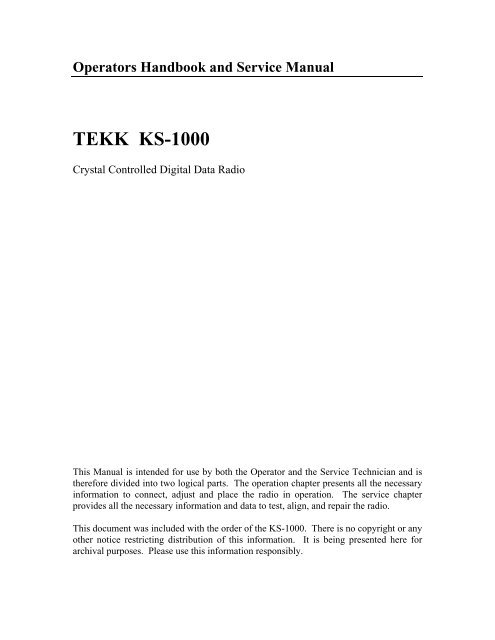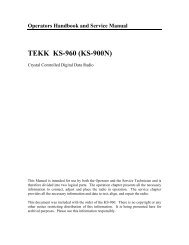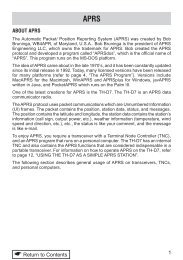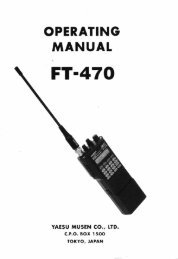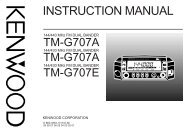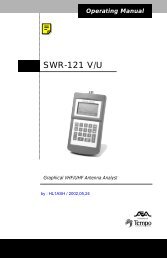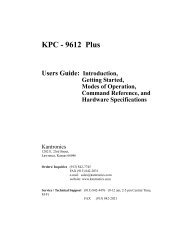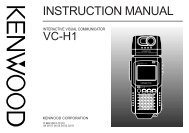Create successful ePaper yourself
Turn your PDF publications into a flip-book with our unique Google optimized e-Paper software.
Operators Handbook and Service Manual<strong>TEKK</strong> <strong>KS</strong>-<strong>1000</strong>Crystal Controlled Digital Data RadioThis Manual is intended for use by both the Operator and the Service Technician and istherefore divided into two logical parts. The operation chapter presents all the necessaryinformation to connect, adjust and place the radio in operation. The service chapterprovides all the necessary information and data to test, align, and repair the radio.This document was included with the order of the <strong>KS</strong>-<strong>1000</strong>. There is no copyright or anyother notice restricting distribution of this information. It is being presented here forarchival purposes. Please use this information responsibly.
IntroductionThe <strong>KS</strong>-<strong>1000</strong> Series is available in a Low and High Band configuration. The suffix Land H indicate Low and High respectively. The Low Band radio is intended foroperation between 430 and 450 MHz. The High Band version for operation between 450and 470 MHz. Because there are a number of component differences between the Lowand High Band Radios it is not generally feasible to use a Low Band Radio on a HighBand Frequency. The opposite case also being true. There is enough mounting space inthe radio case for the inclusion of a miniaturized modem or other special purpose devices.Performance SpecificationGENERALFCC Acceptance ID # GOX<strong>KS</strong>-900 Accepted for FCC Part(s) 15,22, and 90 Frequency Range High BandOperating Voltage7.5 - 12Volt DC, Recommended OperatingVoltage is 9.6Volt DC.Operating Temperature Range-30 to +60 deg CelsiusDimensions in Inches3 5/8 x 2 ¼ x 1 ¼Approximate Weight199 Grams (7 Oz)Antenna Impedance50 OhmUser InterfaceBNC Antenna Interface9 Pin D Type (DB-9)CaseSpot Welded Steel with removable Top andBottom.RECEIVER
Sensitivity 60 dB below carrierHarmonic Radiation> 60 dB below carrierModulationVaractor Controlled Direct FMAttack Time to Stable Data< 8 mSAudio ResponseFlatDistortion < 5%Data Modulation Level for 3.5KHz 50 mV RMSDeviationApproximate Current Drain at 2 Watts 1.3 AData Interface ConnectorPINFUNCTION1 (+) Supply Voltage2 (-) Supply Voltage3 PTT Line, ground to transmit4 Transmit Data In5 Receive Data Out6 No Connection7 Data Ground8 Analog Received Signal Strength Indicator,(RSSI)9 Carrier Detect Level Voltage, CDChapter 1 - Operation
The <strong>KS</strong>-<strong>1000</strong> is a Half-Duplex UHF Transceiver with crystals controlling the Transmitand Receives Frequencies. Half-Duplex indicates that the radio can transmit on afrequency that is different from the receive frequency but can not RECEIVE andTRANSMIT at the same time. For the single channel <strong>KS</strong>-<strong>1000</strong> there is no limit to theseparation of the Transmit and Receive frequencies as long as both are in the same, highor low band. There is no limit to the separation of the receive and transmit frequencies.The frequency controlling crystals are soldered directly to the board so that frequency orcrystal changing in the field is not generally recommended. Further, if the NEWfrequency is more than 3 to 4 megahertz different from the OLD frequency, the radioshould be realigned to insure maximum performance.Very careful attention has been given to the design of both the transmitting and receivingoscillators to insure an extremely high degree of frequency stability, however, please barein mind that no oscillator can be better than the crystal used. Low Cost and Bargaincrystals can not and will not provide the frequency stability your system will require.To place the <strong>KS</strong>-<strong>1000</strong> in operation it is only necessary to connect the Receiver Data Out,(Pin 5), transmit Data In (pin 4), and the PTT (pin 3) to the Modem ad to provide asource of stabilized supply voltage between 7.5 and 12 Volts DC. The PLUS line isconnected to Pin 1 with the ground or minus line connected to Pin 2. Any suitable 50Ohm Antenna adjusted or cut to the operating frequency may be used. (Moreinformation on suitable antenna is given in the Service Chapter.) The use of a goodquality, regulated power supply capable of delivering at least two Amps of current isstrongly recommended. Many Bargain power supplies are effected by transmitterenergy and can not be relied on to deliver the proper voltage when the transmitter iskeyed.CONNECTIONS AND ADJUSTMENTSPin 5, RECEIVED DATA OUTMost modems will have a means of controlling the input level of the received data signal.There is no internal means of adjusting this level in the <strong>KS</strong>-<strong>1000</strong>. The <strong>KS</strong>-<strong>1000</strong> willdeliver a DC coupled signal with a level of approximately 750mV RMS. The levelcontrol in the modem should be adjusted to accept this signal. Please remember that theReceived Data Signal out of the <strong>KS</strong>-<strong>1000</strong> is direct coupled and will have a DCcomponent.Pin 4, Transmit Data IN
A Microampmeter may be connected directly to Pin 8 to indicate the relative strength ofthe received signal. The circuit has a dynamic range of about 60 dB with a scale factor ofapproximately 0.8uA per dB. A meter with a 50 uA movement will provide a suitableindication of the signal strength. The Meter may be left connected at all times.Once installed and placed in operation, a correctly adjusted and aligned <strong>KS</strong>-960 shouldprovide years of trouble free operation.CHAPTER 2 - SERVICEReceiver, GeneralThe receiver is a double conversion superheterodyne with both injection oscillators beingcontrolled by high quality crystals. The first injection signal is generated in a twotransistor chain that multiplies the frequency of the third overtone crystal nine times. Theoscillator is temperature stabilized to insure maximum performance over a wide range oftemperatures. The first IF Frequency is 21.4 MHz with the second IF located at 455KHz.The receiver bandpass is carefully controlled by the use of two specially selected andmatched two pole monolithic ceramic filters in the first IF and a four pole ceramic filterin the second IF.The heart of the receiver is a newly designed surface mounted Motorola chip thatcontains all of the circuitry necessary to produce the detected AF signal, RSSI and CD.The chip also has an internal oscillator and mixer to convert the 21.4 MHz IF to 455KHz,as well as a very high gain IF amplifier and limiter.There are two differences between the <strong>KS</strong>-<strong>1000</strong> and it s predecessor, the <strong>KS</strong>-960. The<strong>KS</strong>-<strong>1000</strong> has a 3Watt Amplifier daughterboard, and an microphone amplifier, for a morerobust modulator.THEORY OF OPERATIONThe Signal arriving at the antenna are coupled over two halfwave lowpass filter sections,L14 and L13 via C1 to the input dual helix transformer T1 and to the base of the RFamplifier Q1. Q1 provides approximately 20 dB of gain. A second dual helix filtercouples the signal from the collector of Q1 to the base of the mixer Q2. The base of bothQ1 and Q2 are protected from dangerously strong signals by the diodes D1 and D2respectively.
The injection signal out of the first Local Oscillator chain is coupled via C5 to the emitterof Q2. T3, the collector load for the mixer transistor, is tuned to 21.4MHz. Furtherfiltering and bandpass shaping is provided by the ceramic filters F1 and F2.Q5 is a wide band amplifier which provides enough gain to offset the filter loss but isused primarily to match the filter impedance to the input of the IC1 receiver chip.The input, Pin 16, of IC1 is connected directly to the internal mixer. Pins 1 and 2 are thefrequency controlling pins of the internal oscillator. A 20.945 MHz crystal is connectedto Pin 1. When the 21.4 MHz signal is mixed with the 20.945MHz crystal signalfrequencies of 910 and 455KHz are produced. The 455 KHz signal out of the mixer, Pin3, is selected by the 4 pole filter F3. After filtering the signal is reinserted via Pin 5, tothe input of the internal high gain main IF amplifier and limiter.Following the IF amplifier is a Quadrature Discriminator type detector. T6 is theQuadrature Coil. The recovered Data signal is amplified and available at Pin 9. C15 andR23 are a lowpass filter removing some of the high frequency hiss componentsgenerated in the IF amplifier and detector. The filtered Data Signal is reinserted via Pin10 to the internal AF amplifier where its level is raised to approximately 750 millivolts.The RC combination of R72 and C18 form a lowpass filter removing the rest of thehiss components and couple the amplified Data Signal to the Data Out, Pin 5, on theDB-9 interface connector.The main IF amplifier also provides a DC voltage at Pin 13 that is analog to the strengthof the received signal. This voltage, called the RSSI, can be connected directly to a 0-50uA meter to give a relative signal strength indication. A portion of this signal is alsocoupled via R13 to the Carrier Detect Switch, Q6.The carrier detect level control VR2 is normally set to the point where Q6 is notconducting which results in a high level at Pin 12 of IC1. When a carrier is received andthe RSSI voltage rises to a point where Q6 goes into conduction, the voltage at Pin 12,IC1 goes to the low value. Pin 12, IC1 is the input to an internal Schmitt Trigger whoseoutput is connected to Pin 14. When Pin 12 is high (no signal), Pin 14 is also high.When Pin 12 goes low (signal present) Pin 14 will also go low. Please note that Pin 14 isconnected to the +6volt DC buss via the pull-up resistor R12.Using third overtone crystals, the receiver 1 st oscillator, Q4, also operates as a tripler.The thermistor in the emitter circuit of Q4 insures that the drive tot he crystal is almostconstant with varying temperature and compensates for the negative drift that is commoncrystals. This in turn greatly enhances the overall frequency stability. A positive voltageis applied to the anode of the diode D5 in the emitter circuit of Q4 when the transmitter isturned ON. This causes Q4 to cut off stopping oscillation and effectively muting ordisabling the receiver.T5 in the collector of Q4 is tuned to the third harmonic of the crystal frequency andcouples this energy to the frequency tripler stage of Q3. Diode D6 enhances the
harmonic content of the energy out of T5 and also serves to stabilize the base bias of Q3.T4 in the collector of Q3 is a dual helix filter tuned to the ninth harmonic of the crystalfrequency. Energy is coupled out of T4 via C5 to the emitter of the mixer Q2. Thefrequency of the injection signal can be checked with a spectrum analyzer or sensitivehigh impedance counter at TP1. TP2 in the emitter of Q3 provides a means to check forthe presence of drive out of the oscillator.All of the receiver stages are supplied with a constant +B voltage from the regulatortransistor Q10. This voltage can be checked at TP11. The base of Q10 is fixed at 6.2volts via the Zener Diode D10. To insure very fast receiver recovery, the receiver +Bbuss is not switched off during transmit.TRANSMITTER, GENERALThe transmitter is a straight forward direct modulated FM transmitter deliveringapproximately 2 watts to a 50 Ohm load. The crystal frequency is multiplied a total of 27times (3 x 3 x 3) before being amplified to the 2 watt level by the pre-driver, driver, andfinal transistors. True direct FM modulation is achieved by the use of a voltage variablediode capacitor between the crystal and the base of the oscillator stage. Varying themodulation voltage to the diode will cause a proportional change in the oscillatorfrequency resulting in direct Frequency Modulation. A specially selected IC Op amp isused to amplify, shape and filter the Data Modulation Signal. The FM deviation level isadjustable via VR1.Theory of OperationUsing fundamental crystals in the frequency range of approximately 16MHz, thetransmitter oscillator transistor Q6 provides a very stable drive to the following frequencymultiplier chain. Careful component selection and the use of a thermistor to compensatefor the negative drift common to all crystals insure a very high degree of frequencystability over a wide range of operating temperatures. A capacitive diode is used to shiftthe crystal frequency in step with the modulation producing a true frequency modulationcharacteristic that is essentially flat over the entire range of the modulation signal.Each of the three tripler stages, Q11, Q12, and Q13 are operated with a small amount offorward bias to increase their efficiency. All three stages are double tuned to insure aclean, harmonic and spurious free, drive to the pre-driver Q14.Q14 and Q15 raise the signal level to approximately 300 milliwatts to drive the finaltransistor, Q16 to the 2 watt level. Both Q14 and Q15 have their bases slightly forwardbiased to increase efficiency. The forward bias aat the base of Q15 is further stabilizedby the diode D14. Optimum energy transfer between the stages is accomplished byadjusting the trimmers TC3 and TC4. The final transistor Q16 is operated class C withthe collector connected directly to the trimmers TC5 and TC6. Two halfwave lowpass
filter sections are used between Q16 and the antenna connector to insure that spuriousand harmonic radiation is held to a level at least 60 dB below the carrier.The switch transistor Q9 is used to pass voltage to the transmitter when the PTT line isgrounded. In the transmit mode Q9 conducts connecting supply +B to the transmittervoltage regulator transistor, Q8.The base voltage of Q8 is held constant by the Zener Diode D9. The emitter voltage ofQ8 is then a constant value around 5 volts. This 5 volts (T5) is used to supply theoscillator, multipliers and drivers as well as the modulation amplifier IC2.There is currently no additional information on the 3 Watt Amplifier daughterboard.ALIGNMENTSuggested Test Equipment<strong>KS</strong>-<strong>1000</strong> Test JigTwo-way Radio Testset or or FMmodulated signal Generator withcalibrated attenuatorLinear FM detectordeviation Meterdistortion analyzer SINAD er Universal Volt/Ohm Meter with 11Megaohm input impedanceRF voltmeter or probe for the Universal OscilloscopeVolt/Ohm MeterCalibrated RF Power Meter with a 50Ohm Dummy LoadCounter with +/- 2 x 10-8 th accuracy at500MhzSpectrum Analyzer with 0-3Ghz range 20 dB directional coupler40-50 dB 50 Ohm 430-470MHz Stabilized Power Supply 0 - 15 Vdc, 3tunable Notch FilterPhilips No. 1 Screw DriverConnection cables and adaptersAmp.Alignment tools with 0.8 and 3mmCeramic Blades<strong>KS</strong>-<strong>1000</strong> TEST JIGA simple test jig should be fabricated to allow connection of all input and output signalsto the available test equipment and to simplify tests and adjustments. The test jig can be
constructed in a small box with a 50 uA panel meter connected to the RSSI line, a LEDconnected to the CD line and a switch connected to the PTT line.Receiver Alignment1) Connect the <strong>KS</strong>-<strong>1000</strong> to the test jig, power supply, SINAD, linear detector, distortionanalyzer, and the signal generator.2) Adjust the signal generator to receive frequency and set the output level to 1mV.Adjust the modulation to <strong>1000</strong> Hz(*) with a deviation of 3.5 KHz(*) Note: If the distortion analyzer uses a frequency other then <strong>1000</strong> Hz, adjust themodulation to that frequency.3) If the test jig meter or the SINAD indicates that the signal is passing through thereceiver, adjust the trimmer TC101 for an indicating of minimum distortion on thedistortion analyzer.4) If there is no indication that a signal is passing through the receiver, connect thespectrum analyzer or a sensitive high impedance counter to TP2, the emitter of Q102,and alternately adjust T106 and T105 and the trimmer TC101 for an indication ofenergy at a frequency of 21.4 MHz below the receiver frequency. The finaladjustment of TC101 is to be performed as in step 7.5) Using the test jig meter or the SINAD, adjust T101 to T103, T105, and T106 formaximum on the test jig meter or SINAD. As each adjustment is made, reduce theoutput level of the signal generator to keep the meter indication in the lower one thirdof the meter scale. Repeat the adjustments several times as there is some interaction.6) Carefully adjust the trimmer TC101 and the core of the Quadrature coil T104 forminimum distortion. A value of less then 5% should be attainable.7) Check that a SINAD of 12dB is obtainable with less than 0.35uV at the antennaterminal.8) With the CD threshold control, VR101 set to the middle of its range, check that thetest jig CD LED is OFF with no signal and ON with a signal level of approximately0.5uV. Now check that the switch point can be varied with the setting of VR101.9) Check that the RSSI meter indication is essentially linear over a range of 50 dBstarting at 0.5uV. NOTE: There will be some compression toward the high end of thescale. This is natural and to be expected.
10) Connect an oscilloscope to the receiver DATA OUT line. With the signal generatormodulation set to <strong>1000</strong> Hz, and a deviation of 3.5KHz, set the signal generator outputlevel to 100uV and check that the waveshape is clean and approximately 700mV P/P.Increase the signal generator level to 1mV. There should be no noticeable change inthe shape or amplitude of the wave form.11) ***CAUTION*** DO NOT TRANSMIT INTO THE SIGNAL GENERATOR.Using the PTT switch on the test jig, switch between transmit and receive severaltimes. Not that the receiver starts as soon as the PTT switch is released.12) While observing the wave form on the oscilloscope, change the output voltage of thepower supply between 8 volts and 12 volts and note that there is no noticable changein the wave form.THIS COMPLETES THE RECEIVER ALIGNMENTTransmitter Alignment1) Connect the <strong>KS</strong>-<strong>1000</strong> to the test jig and to the 20dB directional coupler, notch filter,spectrum analyzer, counter and 50 Ohm power meter.2) Close the PTT switch and note if transmitter output is indicated.3) If transmitter output is indicated make a rough preliminary adjustment of T201 toT205 and the trimmers for maximum output. Now precede to STEP 5.4) If no indication of output is available connect a spectrum analyzer or a sensitive highimpedance counter to TP3 and check for oscillator operation. The counter shouldindicated the crystal frequency.*** Please note that after the adjustment is made in each of the following steps youshouldcheck for an indication of transmitter output. As soon as output is available,jump toSTEP 5.4A) Connect the voltmeter to TP4 (emitter of Q205) and adjust T204 and T205 for amaximum indication. Check for an indication of transmitter power output.4B) Connect the voltmeter to TP5 and adjust T203 and T202 for a maximum indication.Check for an indication of transmitter output.4C) Connect the RF voltmeter to TP6 and adjust T201 for a maximum indication. Checkfor an indication of transmitter output.
4D) Connect the RF voltmeter to the collector of Q201 and adjust TC202 for a maximumindication. Check for an indication of transmitter output.5) Adjust the trimmer TC201 for the correct transmitter frequency.6) Connect the spectrum analyzer between the radio and the 50 ohm power meter. Setthe Spectrum analyzer to display a frequency spectrum from zero to 3GHz. Adjustthe Notch filter connected in front of the spectrum analyzer to notch out thetransmitter carrier.7) Make the final adjustment of T201 to T205, and the trimmers TC202 for maximumpower output. Keep a constant check of the spectrum analyzer to insure thatharmonics and all spurious signals are at least 60 dB below the level of the carrier.8) Modulate the transmitter with a 1KHz signal with an amplitude of 50mV. AdjustVR202 to produce 3.5 KHz of deviation on the linear detector. Check that thedistortion is less than 5%.9) Increase the level of the modulating signal by 10 dB and check that deviation doesnot exceed 4.5KHz10) Switch between Receive and transmit several times and note that the transmitterstarts as soon as the PTT switch is closed.11) Vary the voltage out of the power supply system between 8 and 12 volts and note thatthe transmitter starts as soon as the PTT switch is closed and that the harmonics andspurious signals remain at least 60dB below the carrier level. The power output willvary with the supply voltage. This is natural and to be expected.12) Connect the <strong>KS</strong>-<strong>1000</strong> via a very short piece of cable to the power meter. Connect thevoltmeter to Pin 5 (the red wire) on the 6 pin connector CN1. Set the power supply todeliver 10 Volts as indicated on the Voltmeter. Check that the transmitter poweroutput is at least 5 wattts.THIS COMPLETES THE TRANSMITTER ALIGNMENTAntenna ConsiderationsThe <strong>KS</strong>-<strong>1000</strong> will operate satisfactorily with any 50 Ohm antenna cut for the operatingfrequency. If only short, (less than a mile or 6-8 KM), line of sight distances are to becovered, simple Rubber Duck type antenna are suitable. If it is necessary to operate
over greater distances, the antenna used becomes extremely important. In all cases it isadvisable to consult your dealer or to contact the factory for assistance in planning andselecting the proper antenna system.


